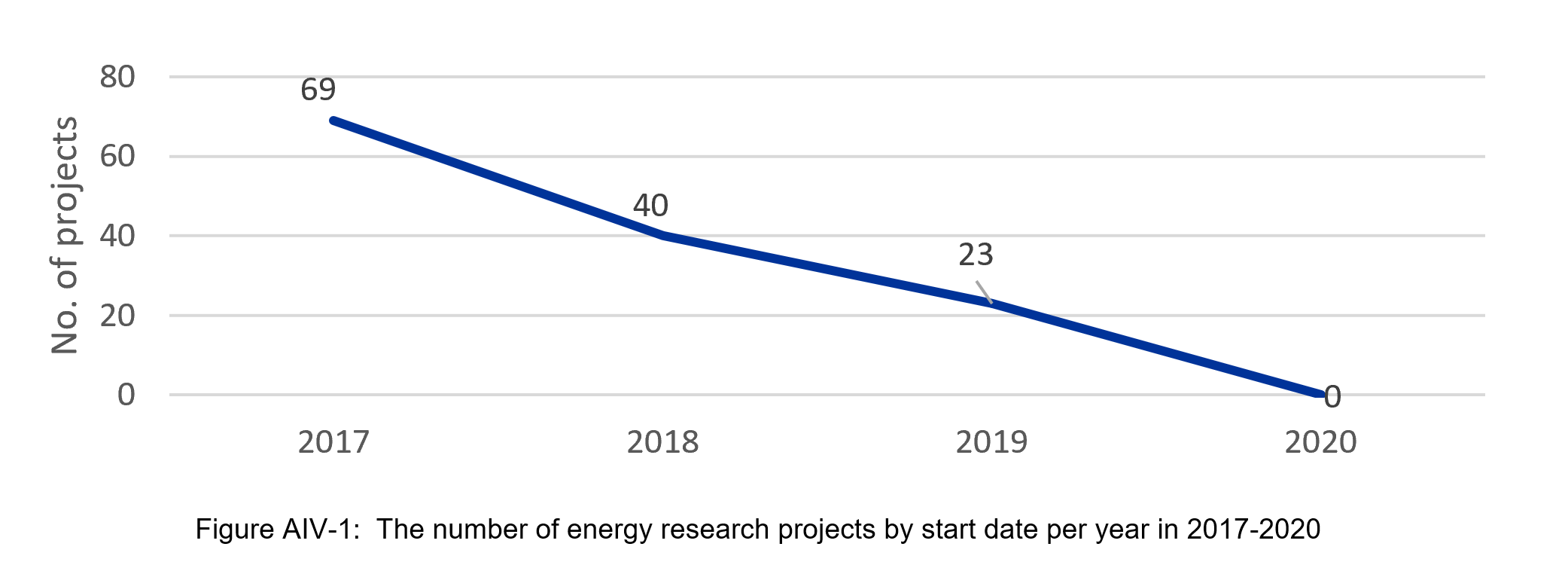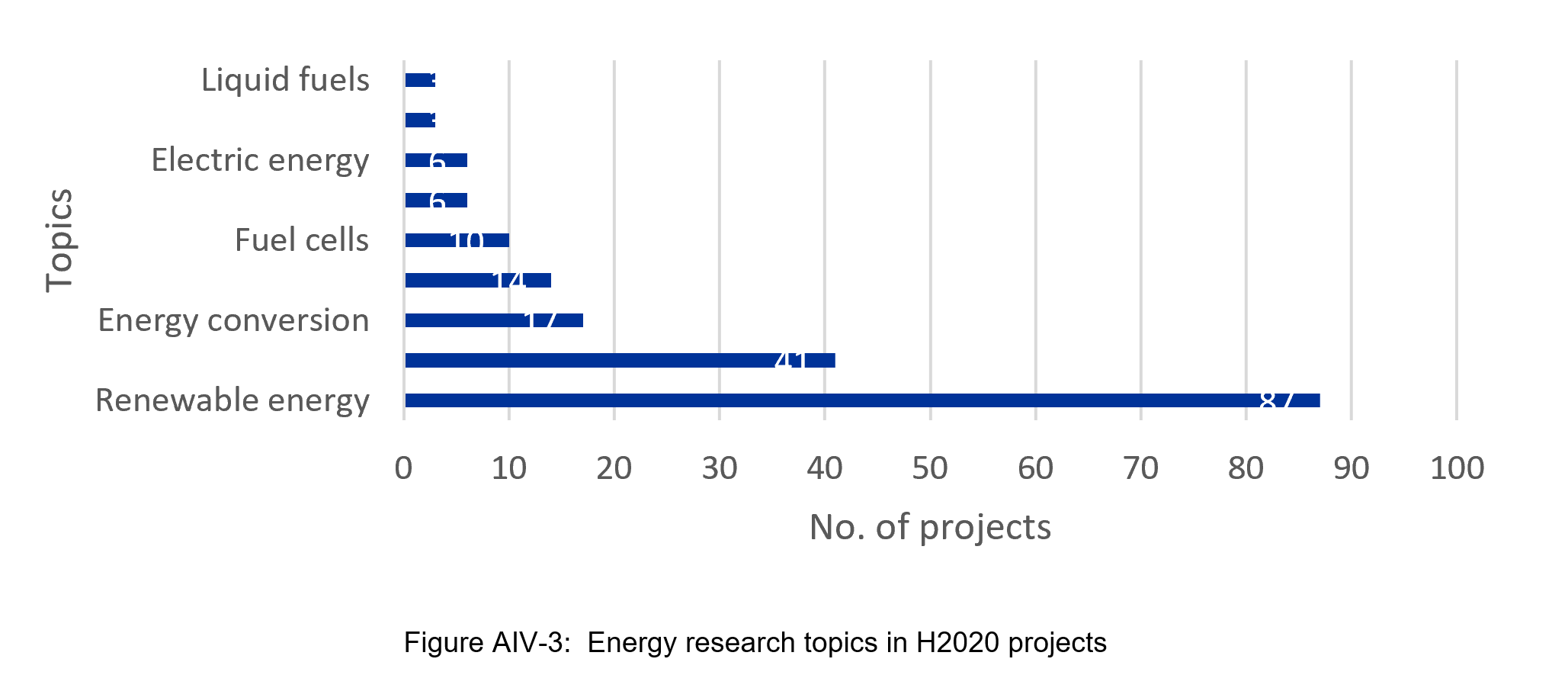R&D - EUON
Energy
This section gives an overview of the Horizon 2020 projects focused on energy. The projects that contained the keyword ‘energ*’ in their subject classification were filtered out from the general collection of nanotechnology projects developed for the study.
In the period 2017-2020, Horizon 2020 funded 132 projects in the field of energy. Projects in energy comprised 11% of all research projects in nanotechnology funded by the EU from 2017-2020. In general, it shows that the interest in nanotechnology in energy was not so high.
Analysis of the start date of energy projects shows that most of them received funding and started in 2017 and 2018. H2020 covered the 2014-2020 period, so with 2017 as a mid-term of the programme, it is not surprising that most projects started during this period. The decreasing number of research projects towards the end of the funding period is explained by the fact that most research projects require several years to complete.

H2020 contained several high-level programmes/priorities/specific actions and their sub-programmes. Three thematic and two horizontal high-level programmes funded nanotechnology research and innovation:
- Priority “Excellent science” (1) aimed to improve the excellence of the European research base and consolidate the European Research Area (ERA) to increase the global competitiveness of European research and innovation.
- Priority “Industrial leadership” (2) focused on boosting the development of the technologies and innovations that will underpin future businesses and help innovative European SMEs to grow into world-leading companies. This priority contained a sub-programme targeted at nanotechnologies.
- Priority “Societal challenges” (3) focused on the societal challenges that were identified in the Europe 2020 strategy and aimed to encourage sufficient research and innovation efforts necessary to cope with these challenges and achieve the EU strategic goals.
- Specific objective “Spreading excellence and widening participation” (4) was a horizontal objective of Horizon 2020 aimed at pooling research and innovation talents in Europe, nurturing and connecting pools of excellence to maximise and fully exploit Europe’s research and innovation potential.
- Specific objective “Science with and for society” (5) was a horizontal objective of Horizon 2020 aimed at strengthening the collaboration between science and society by engaging citizens in science and using collective intelligence for solving research problems, promoting scientific careers, etc.
Each of the described high-level programmes contained the whole hierarchy of sub-programmes. Usually, one project received funding through a combination of programmes. Those combinations of (sub)programmes from 2017-2020 were filtered out. Figure AV-2 gives an overview of programmes and subprogrammes that funded energy research under Horizon 2020.

From 2017-2020, Horizon 2020 energy research projects were more focused on scientific excellence rather than on industrial innovation. Most energy projects received funding under the priority “Excellent science” and its subprogrammes (72 projects, 55%). These subprogrammes are focused on building the capacity of individual researchers and their teams as well as encouraging collaboration between researchers. Substantially less – 46 projects (35%) were funded under the priority “Industrial leadership” that promoted nanotechnology innovation and commercialisation. Twenty-seven projects (21%) also focused on the third priority of Horizon 2020 – Societal challenges. Finally, four projects were focused on the horizontal objective “Spreading excellence and widening participation” and only two projects – on the horizontal objective “Science with and for society”.
According to the project classification applied in Cordis, energy projects focused on nine topics. One project could combine several topics.

Most projects focused on renewable energy (87 projects, 66%). Many of them specified a focus on solar energy (41 projects, 31%) and wind power, while others used the term “renewable energy” in general. Other topics addressed different types of energy and were less visible than the above-mentioned themes. An illustrative example of a project focused on renewable energy is provided in the table below.
| Table AIV-1: An example of a project focused on renewable energy | |||
|---|---|---|---|
| Project title, acronym, (coordinating country) |
Objectives | Start, end dates | Funding (EU contribution) |
| Innovative Photoelectrochemical Cells for Solar Hydrogen Production, FotoH2 (Spain) | The use of solar energy for photoelectrochemically splitting water into H2 and O2 has been widely investigated for producing sustainable H2 fuel. However, no commercialisation of this technology has emerged. Currently, the main obstacles to commercialisation are low solar-to-hydrogen efficiency, expensive electrode materials, fast degradation of prototypes, and energy losses in separating H2 from O2 and water vapour in the output stream. The FotoH2 consortium has identified a new scientific direction for achieving cost-effective solar-driven H2 production, and it has the capability of large-scale prototyping and field-testing the proposed technology. FotoH2 introduces anion-exchange polymer membrane and porous hydrophobic backing concepts in a tandem photoelectrochemical cell, and a novel way to stabilise the photoelectrodes based on a surface phase transformation. This approach allows the use of cost-effective metal oxide electrodes with optimal bandgaps and a simple flow-cell design without corrosive electrolytes. Apart from the already identified Fe2O3/CuO couple, a theoretical screening of earth-abundant metal ternary oxides will be done to identify the most promising materials. These chosen electrode materials will be optimized by doping, nanostructuring and by introducing protective and passivating external layers by the phase transformation strategy. Most of these concepts have been already validated at TRL 3 and preliminary laboratory prototypes were demonstrated. The aim is to increase the TRL to 5 by validating the technology in a system with a module of 1 m2 and achieve a photoelectrolysis device with solar to-hydrogen efficiency of 10 % and a prospective lifetime of 20 years. We aim for breakthroughs in cell lifetime, conversion efficiency, cost-efficiency, and H2 purity. To bring these innovations to market, an exploitation plan is addressed. The consortium includes materials developers and suppliers, device manufacturers and system integrators. |
2018-2021 | € 2 578 971,25 |


